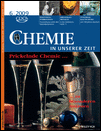Das elastische Jahrhundert. Synthesekautschuke
Abstract
deSynthetische Kautschuke lösen immer mehr Aufgaben, in denen Elastizität gefragt, Naturkautschuk auf Grund seiner Empfindlichkeit gegenüber UV-Licht, Ozon und Hitze aber überfordert ist: Über die Hälfte der heute verbrauchten Kautschuke stammen aus den Reaktoren der Chemischen Industrie. Synthesekautschuke sind ihrem natürlichen “Vorbild” nicht nur in Sachen Alterungs- und Chemikalienbeständigkeit überlegen: Sie können äußerst effektiv an immer neue Anforderungen angepasst werden – etwa durch Variation ihrer Zusammensetzung und Molekülarchitektur, durch Einsatz neuer Katalysatoren und Produktionsverfahren und nachträgliche Modifikation des Polymers. Diese Entwicklungsarbeiten erfordern ein vertieftes Verständnis der Gummichemie und -Physik.
Abstract
enSynthetic rubbers help to solve severe problems in rubber-technology arising from the sensitivity natural rubber shows towards UV-radiation (e.g. sunlight), heat, and ozone: For this reason more than half of the rubber demand nowadays is satisfied by the chemical industry. However, synthetic rubbers are superior to its natural counterpart not only in regard to their ageing resistance and robustness towards several chemicals: They can easily be adapted to new challenges born by a more and more demanding technology – e.g. using improved concepts in the design of rubber molecule architectures, new catalysts or post-polymerization altering of the elastomers. These challenges demand for a deep and clear understanding of rubber's chemistry and physics.




